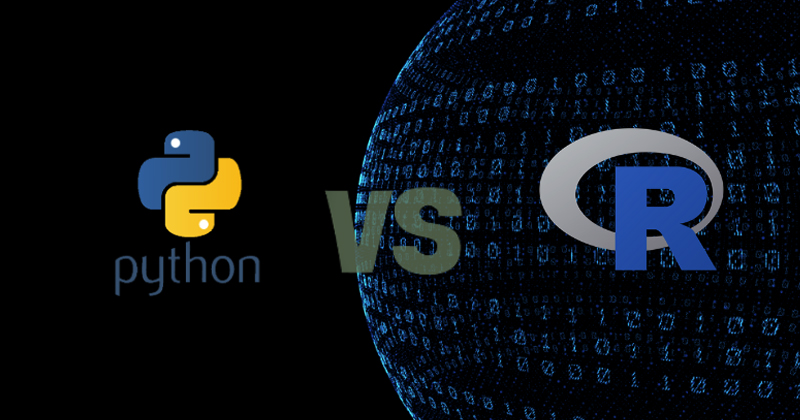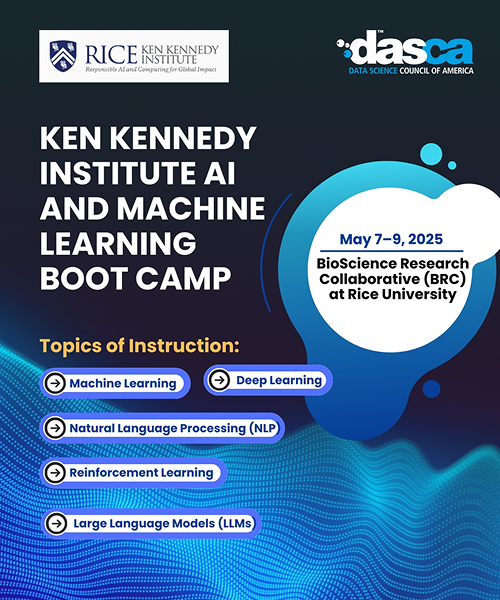
Stepping into a data science career requires mastering a programming language. While SQL talks to databases, Python and R are about transforming raw data into insights. As the most popular programming languages for data science, they often present a challenging choice.
Python is an open-source programming language commonly used in data science as is R— echoing the ongoing dilemma as to which one to choose.
Let’s go through and understand what these two languages are about and explore how they are best used. Because the real question is no longer about determining the best programming language; instead, it is about how to optimize and use either language for specific use cases.
Why Opt for Python?
Python, introduced in February 1991, has become a global leader in many software fields, from data science to web development and gaming. Known for its readability and user-friendly nature, Python is especially welcoming for coding beginners. It is freely distributable, making it a top choice for programmers aiming at efficient code development. Python's interpretative nature simplifies program debugging, and its rich library collection, including Scikit, Keras, Tensorflow, Matplotlib, NumPy, and Pandas, provides advanced functionalities.
Python's prominence is evident in its high rankings on programming language popularity indices like TIOBE and PYPL. The addition of Jupyter Notebook further enhances the data science experience by facilitating live code sharing through a web application. This blend of accessibility, efficiency, powerful libraries, and interactive features solidifies Python's appeal and effectiveness, particularly in the dynamic realm of data science.
Understanding Data Science and Its Operations
At its core, data science is the art and science of extracting meaningful insights from raw data. Data scientists employ a multifaceted approach, combining statistical analysis, machine learning algorithms, and domain expertise to uncover patterns and trends. This process involves collecting vast amounts of data, cleaning and preprocessing it, and utilizing advanced analytics to draw actionable conclusions. The iterative nature of data science ensures a continuous refinement of models and predictions, making it a dynamic and adaptive tool for businesses.
Why Opt for R?
Appearing first a little later in 1993, R, an open-source programming language, was designed for statistical computing and graphics. With a significant position in both the TIOBE Index (11th) and the PYPL Index (7th), R's concise code facilitates the execution of intricate functions, empowering users to employ diverse statistical tests and models such as linear and non-linear modeling, classifications, and clustering.
R's strength lies in its vibrant community, which has curated an extensive collection of data science packages available through the Comprehensive R Archive Network (CRAN). A standout feature is its seamless generation of plots, incorporating mathematical notations effortlessly. Compatible with UNIX, Windows, and macOS, R ensures widespread accessibility. Its flexibility shines through user-specific function definition, and for computationally intensive tasks, users can link C and C++ codes during runtime, enhancing capabilities. Supporting extensions with languages like C++, R stands out for its versatility in statistical analysis and computational tasks.
Understanding the Distinctions Between Python and R
Now let’s understand the distinctions between these two languages—
-
Purpose : Originally meant for specific purposes—Python for various tasks and R for statistics—both languages have become versatile tools in data science.
Python is known for its versatility, used beyond data science due to its clean syntax and broad support. It excels in machine learning, handling complex tasks like deep learning.
On the other hand, R is specialized in statistical data analysis and graphics. While not as versatile as Python, it's excellent for in-depth data visualization. -
Libraries : Python's expansive libraries are for machine learning and scientific computing, including NumPy, Pandas, Matplotlib, Scikit-learn, and TensorFlow.
R, however, takes a different approach, emphasizing specialized packages for statistical analysis and visualization. Hosted in the Comprehensive R Archive Network (CRAN), R includes gems like dplyr, tidyr, ggplot2, Shiny, and Caret. -
Use Cases and Strengths : Python's dominance is evident in machine learning and deep learning domains. Its ability to handle large datasets and integrate seamlessly with web applications positions it as a go-to language for developers building robust and scalable solutions.
Conversely, R excels when statistical learning and data visualization take center stage. Its array-oriented syntax simplifies the translation of mathematical concepts into code, making it a preferred choice for statisticians and analysts seeking to derive meaningful insights from data. -
User Base and Popularity : For your data science career, understanding the strengths and optimal use cases for each language is pivotal in making an informed choice.
Python, being a general-purpose language, attracts software developers transitioning into data science. Its focus on productivity and versatility makes it an ideal choice for building complex applications.
In contrast, R finds its stronghold in academia, finance, and pharmaceuticals, catering to data scientists and researchers with an appetite for statistical analysis. -
Learning Curve and Syntax : Python's readability, simple syntax, and beginner-friendly nature contribute to a smooth learning curve, making it accessible for newcomers to programming and data science.
R, however, presents a steeper learning curve, particularly for those without prior experience in statistical languages. While this may pose initial challenges, the power and expressiveness of R become evident as proficiency grows. -
Common IDEs : Integrated Development Environments (IDEs) play a pivotal role in the efficiency of coding. Python enthusiasts commonly gravitate towards Jupyter Notebooks, JupyterLab, and Spyder.
R enthusiasts, on the other hand, find solace in RStudio, a powerful IDE offering an organized interface for seamless integration of code, data tables, graphs, and outputs.
Table to understand the differences between Python and R
| Aspect | Python | R |
|---|---|---|
| Purpose | General-purpose language, versatile across various domains | Specialized in statistical data analysis and graphics |
| Libraries |
|
|
| Use Cases and Strengths | Dominates in machine learning, deep learning, web apps | Excels in statistical learning, data visualization |
| User Base and Popularity | Attracts software developers, widely popular | Stronghold in academia, data scientists, finance, and pharmaceuticals |
| Learning Curve | Readable, has simple syntax, and is beginner-friendly | A steeper learning curve, powerful with proficiency |
| Common IDEs | Jupyter Notebooks, JupyterLab, Spyder | RStudio |
Use of Python and R in data science
Python and R are pivotal in data science, focusing on identifying, representing, and extracting valuable insights from data for business logic.
Python code excels in:
- Data science and analysis
- Web application development
- Automation/scripting
R excels in:
- Data Manipulation
- Statistical Analysis
- Data Visualization
Nonetheless, both languages offer popular packages for data collection, exploration, data modeling, visualization, and statistical analysis, making them indispensable tools in the field.
Pros and Cons of Python & R
Python Programming
-
Pros
- Versatility: Python excels in general-purpose tasks and data analysis.
- Industry Adoption: Widely embraced across industries with a rich ecosystem of packages like pandas, scipy, and scikit-learn.
- Programming Environment: Support for Conda environments, Spyder, and IPython Notebook ensures a robust development environment.
- Community Support: Python's open-source nature fosters an active community, encouraging contributions for continuous improvement.
-
Cons
- Library Limitations: Python lacks an extensive range of dedicated data science libraries.
- Visualization Challenges: Visualization capabilities are considered less refined compared to R's ggplot2.
- Interpreted Nature: Python's interpreted nature contributes to relative slowness in comparison to compiled languages.
- Mobile Suitability: Less suitable for mobile environments, though efforts can enable usage.
- Resource Consumption: Significant RAM usage can lead to slower processes, especially with numerous accessed objects.
- Database Access: Database access layers are less developed than alternatives like JDBC and ODBC.
R Programming
-
Pros
- Platform Independence: R smoothly runs on UNIX, Windows, and Mac platforms.
- Statistical Expertise: Preferred for statistical analysis, commonly used in academia and research.
- Package Support: Extensive support for specialized packages like tidyverse, ggplot2, and RStudio for enhanced data analysis.
- Open Source: R is freely available, encouraging contributions and optimizations.
- Data Wrangling: Efficient data wrangling supported by packages like readr and dplyr.
-
Cons
- Learning Curve: Considered more challenging for beginners due to its statistical focus.
- Performance: Slower performance for computationally intensive tasks and large-scale data processing.
- Memory Consumption: High memory usage may lead to performance slowdowns with growing data.
- Security Challenges: Lacks basic security features, posing integration challenges in web applications.
- Big Data Handling: This can be unmanageable for Big Data handling, though integrations exist to facilitate it.
Which Language Should You Learn? Python or R?
As already mentioned in the beginning the main question is not about determining the best programming language; instead, it is about how to optimize the use of both languages for specific use cases.
Choosing between R and Python for data science involves a personalized approach. Assess your programming background –
- Python's simplicity suits beginners, while R is familiar to those versed in statistical languages. Consider team dynamics, as aligning with colleagues' preferences enhances collaboration.
- Define your problem-solving goals.
- Reflect on personal interests within data science, guiding your choice based on statistical intricacies or machine learning pursuits.
Ultimately, the decision between Python and R boils down to understanding project needs and personal preferences. You will often find value in becoming proficient in both languages— crafting a toolkit that aligns seamlessly with the intricacies of their analytical endeavors.
End Note
Choosing between Python and R in data science depends on project needs and personal preferences as per your data science career. While Python's versatility makes it a preferred choice for many data scientists, R's strength lies in its statistical capabilities. The popularity of Python is notable, and to explore deep into the reasons behind its widespread use, you might refer to what makes python the go-to for data scientists.



































